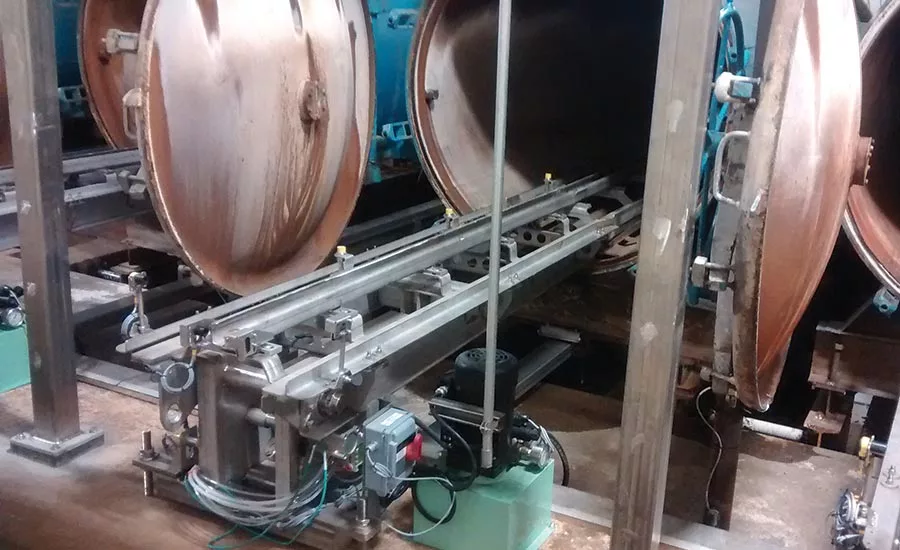Engineering R&D
Making safer retorts
Automated loading and unloading of retorts protects workers from being burnt or crushed

Greg Jacob, general manager, Allpax

When I worked in engineering, one of my employers had a fenced robotic cell, including a small forge to make tuning assemblies and cavities for commercial radio equipment. The main purpose of the fence was to keep employees away from dangerous heat and molten metal while the robot moved work pieces in and out of the forge.
Retorts present their own unique worker safety issues—especially the retorts that require manual loading, which involves moving one-ton or heavier metal baskets in and out of long, dark, hot, and slippery cylindrically-shaped pressure cookers. You can’t fence a retort like the robotic cell I described. What, then, is a good safety solution for keeping workers out of harm’s way, yet still allowing for efficient loading and unloading?
This was the question that customers asked Allpax, a product brand of ProMach. Allpax manufactures and services retort room equipment and automated systems. The company began looking for a practical solution.
Greg Jacob, general manager, with the help of Phillip LeBlanc, lead engineer, and Jonny Watkins, director of software development, devised the Allpax Telescopic Basket Loading System for making retort loading and unloading much safer. Their patent-pending invention is now available.
I spoke with Jacob to gather a few details about the invention.
FE: Describe the construction and operation of the Telescopic Basket Loading System. How much plant floor space does it require?
Jacob: The telescopic loader is a motor driven, heavy-duty push/pull chain system used to load/unload baskets of product in a retort. For two-door retorts, the baskets are pushed in one door and, after processing, pushed out the other.
Push/pull chains are made from precision manufactured chain links of a specific design that enables the chain to push as well as pull heavy loads. The chain links have an interlocking finger at one end of each link, allowing the chain to roll or fold-up in one direction only. In other words, the chain is rigid going out—it won’t bend back on itself while pushing—but is flexible on its return. It rolls back on a spool. The chain can be any length to accommodate the specific vessel.
The telescopic loader can be mounted stationary in front of a vertical lift door retort or mounted with a lift bridge for a swing open door. The lift bridge allows the door to swing open or closed. Telescopic loaders can also be built onto a shuttle that traverses a bank of retorts, with one loader servicing many retorts. Floor space required is roughly 8-12 feet in front of the retort, depending on basket size.
FE: How long has it been in development?
Jacob: The development began early in 2016. A detailed design and patent application followed. The first installation of the Telescopic Basket Loading System was 14 months later in 2017.
FE: What size retorts can it handle?
Jacob: The system can handle any commercial size retort currently built and works with both single- and double-door retorts. The single-door retort requires a push/pull style arm with latching system that engages during the pull sequence. Double doors require a simpler model—no latch—as they are built solely for a pushing action.
FE: Obviously, this machine will work with Allpax retorts, but can it work with other pre-existing retorts? If so, what prep work needs to be done?
Jacob: Allpax can retrofit any brand of retort. The upgrade requires a chain guide system to be welded to the inside bottom of the retort. Allpax is an American Society of Mechanical Engineers (ASME) certified facility. Our engineering group and certified welders are capable of handling field retrofits. This maintains the ASME certification of the vessel.
FE: What does it require in the ways of controls to operate?
Jacob: The motor driven chain system is outfitted with a variable frequency drive (VFD) for speed and torque control of the motor, an encoder for accurate positioning, and sensors to confirm position. The system can be integrated into an existing control system or have a standalone PLC/HMI based platform for control.
FE: When you install the loader at an existing operation, how much of the telescoping loader must be customized or designed to fit?
Jacob: There is actually very little customization. The motor/chain size is determined by the amount of weight to be pushed/pulled, and we have designs to deal with both swing open and vertical doors. As long as there is room near the bottom center of the retort to install the chain guide, the retrofit is straightforward.
FE: What are the energy and power requirements to operate the loader/unloader?
Jacob: We use 1.5- to 3-horsepower motors to drive the chain. Very little energy is required.
FE: What’s the typical lead time for retrofit and new installations?
Jacob: Currently, retrofits to an existing retort system require six to seven months for design and hardware to be built. The actual installation goes relatively quickly so that downtime is minimized. Delivery of a new Allpax retort line is approximately eight months. The loader does not change the new retort line delivery window.
FE: How many have been installed?
Jacob: We have installed these systems at four different locations, servicing more than 20 retorts.
FE: With AllTrax basket tracking software, are there any procedural/process differences when using the new loader/unloader compared to a fully manual operation?
Jacob: AllTrax utilizes strategically placed bar code scanners or hand-held scanners and basket-mounted stainless steel 2D bar code tags. With AllTrax, every basket’s progress through the retort room is tracked. Any deviation from the specified route, such as a basket going to the wrong retort or bypassing a retort sets off an alarm. AllTrax is designed to lower the risk of product recall. Legacy systems based on color changing cook tags and other scanning methods tend to be less fail safe.
Integrating AllTrax with the telescoping loader does not pose any unusual problems. Together these systems lower two types of risk: product recall through 100 percent basket tracking and worker injury by keeping people out of harm’s way. Together they remove two of the most concerning issues inherent in the sterilization process. Both can be retrofitted or utilized on new equipment.
For more information, visit www.allpax.com
Looking for a reprint of this article?
From high-res PDFs to custom plaques, order your copy today!






